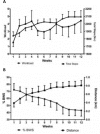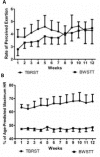Exercise Training in Progressive Multiple Sclerosis: A Comparison of Recumbent Stepping and Body Weight-Supported Treadmill Training
- PMID: 27803637
- PMCID: PMC5087577
- DOI: 10.7224/1537-2073.2015-067
Exercise Training in Progressive Multiple Sclerosis: A Comparison of Recumbent Stepping and Body Weight-Supported Treadmill Training
Abstract
Background: There is evidence of the benefits of exercise training in multiple sclerosis (MS); however, few studies have been conducted in individuals with progressive MS and severe mobility impairment. A potential exercise rehabilitation approach is total-body recumbent stepper training (TBRST). We evaluated the safety and participant-reported experience of TBRST in people with progressive MS and compared the efficacy of TBRST with that of body weight-supported treadmill training (BWSTT) on outcomes of function, fatigue, and health-related quality of life (HRQOL). Methods: Twelve participants with progressive MS (Expanded Disability Status Scale scores, 6.0-8.0) were randomized to receive TBRST or BWSTT. Participants completed three weekly sessions (30 minutes) of exercise training for 12 weeks. Primary outcomes included safety assessed as adverse events and patient-reported exercise experience assessed as postexercise response and evaluation of exercise equipment. Secondary outcomes included the Multiple Sclerosis Functional Composite, the Modified Fatigue Impact Scale, and the Multiple Sclerosis Quality of Life-54 questionnaire scores. Assessments were conducted at baseline and after 12 weeks. Results: Safety was confirmed in both exercise groups. Participants reported enjoying both exercise modalities; however, TBRST was reviewed more favorably. Both interventions reduced fatigue and improved HRQOL (P ≤ .05); there were no changes in function. Conclusions: Both TBRST and BWSTT seem to be safe, well tolerated, and enjoyable for participants with progressive MS with severe disability. Both interventions may also be efficacious for reducing fatigue and improving HRQOL. TBRST should be further explored as an exercise rehabilitation tool for patients with progressive MS.
Figures


References
-
- Motl RW, Pilutti LA. The benefits of exercise training in multiple sclerosis. Nat Rev Neurol. 2012; 8: 487– 497. - PubMed
-
- Latimer-Cheung AE, Pilutti LA, Hicks AL, et al. The effects of exercise training on fitness, mobility, fatigue, and health related quality of life among adults with multiple sclerosis: a systematic review to inform guideline development. Arch Phys Med Rehabil. 2013; 94: 1800– 1828. - PubMed
-
- Dalgas U, Ingemann-Hansen T, Stenager E. Physical exercise and MS recommendations. Int MS J MS Forum. 2009; 16: 5– 11. - PubMed
-
- Pilutti LA, Hicks AL. Rehabilitation of ambulatory limitations. Phys Med Rehabil Clin N Am. 2013; 24: 277– 290. - PubMed
-
- Beer S, Aschbacher B, Manoglou D, Gamper E, Kool J, Kesselring J. Robot-assisted gait training in multiple sclerosis: a pilot randomized trial. Mult Scler. 2008; 14: 231– 236. - PubMed
LinkOut - more resources
Full Text Sources
Other Literature Sources
